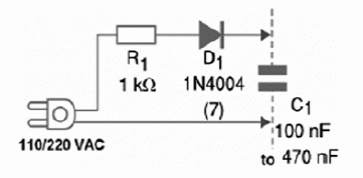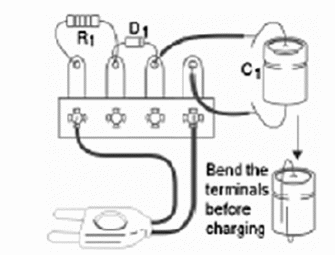This project is simple but requires the aid of a teacher or instructor to charge the capacitor—high voltage involved! We are going to describe a simple joke you can apply to have some fun with your friends. It is a very interesting attraction for a science fair stand. Even the smartest people will be surprised with the results of this demonstration, specially the ones who are afraid of electric shocks.
The joke consists in charging a capacitor and then begging a friend to take it when you throw. You will alert the other person first saying:
- Catch it!
And, when the person catches the capacitor, the device (with an inoffensive appearance) will discharge more than 150 V across its hands. Certainly the shock lasts only some tenths of a second, but it is enough to scare the person.
You will have to explain your joke, of course, but that will be no problem for you, who knows all about capacitors. To repeat the joke, you will have to recharge the capacitor. A special circuit using the AC power line voltage will be used for this task. Our project consists of just building the charger circuit, since the other part is only a capacitor.
In order to not cause a severe shock, but only enough to surprise your friends, the capacitor must have low values, between 100 nF and 470 nF. Polyester, paper or other similar types rated to voltages from 200 V to 400 V (not the voltage of the charge) can be used. Tubular types are preferred.
How it Works
By connecting the plates or armatures of a capacitor to a voltage source, the capacitor charges with the voltage of this source. The charge is kept by the capacitor as long as the armatures are disconnected from any external circuit.
When the armatures are interconnected by an external circuit, your body for instance, the capacitor discharges producing an intense current. In our case the external circuit is your friend and the discharge current causes the shock!
So, what we have to do is charge the capacitor to the voltage of our power supply and keep its terminals separated. When we throw the capacitor, as long as your friend catches it, his/her hand close the circuit causing the discharge and then the shock.
To generate a DC Voltage, we are going to assemble a power supply, since alternating current does not charge capacitors.
Building
Figure 1 shows the circuit of the DC Power supply used to charge the capacitor.

The few components used in the project can be soldered to a terminal strip (figure 2).

If your AC power line voltage is 110/117 or 127 VAC you can use the 1N4004 or equivalent for D1. But, if your AC power line voltage is 220 V or 240 VAC the recommended diode is the 1N4007.
The resistor is a 1 W type or larger. Be careful with the circuit, because it has exposed parts connected to the AC power line. It is highly recommended to house the circuit inside a plastic box.
How to Use
First, we observe that the shock produced by the capacitor is not dangerous, since it only lasts some tenths of a second, a time interval too short to hurt anyone. In order to have this shock, the people must touch the two terminals of the component at the same time, closing the circuit.
This can be achieved by just bending the terminals in a way that allows the contact with the hand. If a person catches the capacitor by one terminal, the circuit is not closed and no shock is produced.
For the demonstration or joke, charge the capacitor by connecting it to the output of the supply for some seconds. When your friend or any person comes near, throw the capacitor asking them to catch it. When throwing it, make sure not to touch the two terminals at the same time, so you will not be a victim of the shock and you will not discharge the capacitor.
Do not keep the capacitor charged by more than 1 or 2 minutes. It tends to lose the charge in a short time interval.
What to Explain
Find in the books and Internet texts about the operational principle of capacitors or ‘condensers’ as they are also called, taking as example the Leyden Jar. Explain to the visitors that, when the Leyden Jar was invented almost 300 years ago, they used it to shock one another. It is a very old joke!
Explain how a capacitor is charged and how the charges are placed in the armatures. Show that the amount of charge stored in a capacitor depends on the size and separation of the armatures and the material placed between them. Show how you can charge a capacitor by connecting it to the power supply.
Suggestions
Another way to show the discharge of a capacitor is using a neon lamp as load. The lamp will glow by a moment due the discharge. You can also touch the capacitor’s terminals to the terminals of a loudspeaker. The discharge will produce an audible crack.
Important observation: do not use capacitors with values higher than the recommended. The heavy shock produced by them can become dangerous. Never apply the joke to people who use pacemakers or have heart diseases.
D1—1N4004 or 1N4007—silicon diode—see text
R1—1 k?—1 W—resistor—brown, black, red
C1—100 nF to 470 nF—200 or 400 V WVDC—polyester capacitor (tubular)
Other:
Terminal strip, plastic box, power cord, wires, solder, etc.



